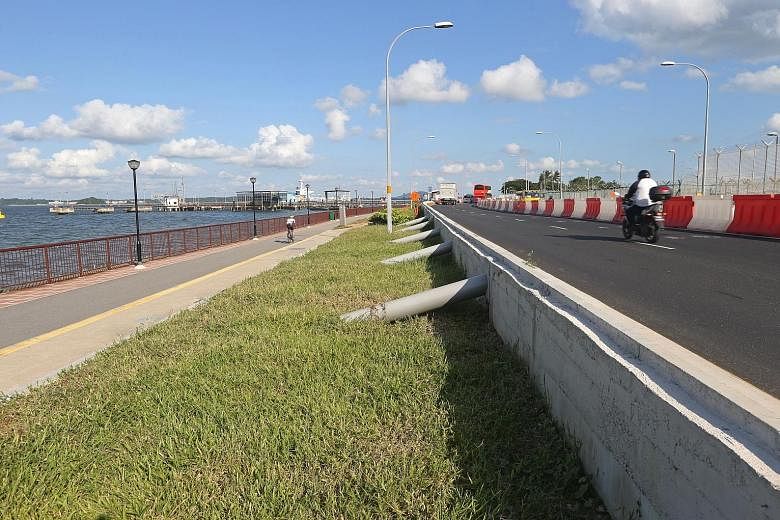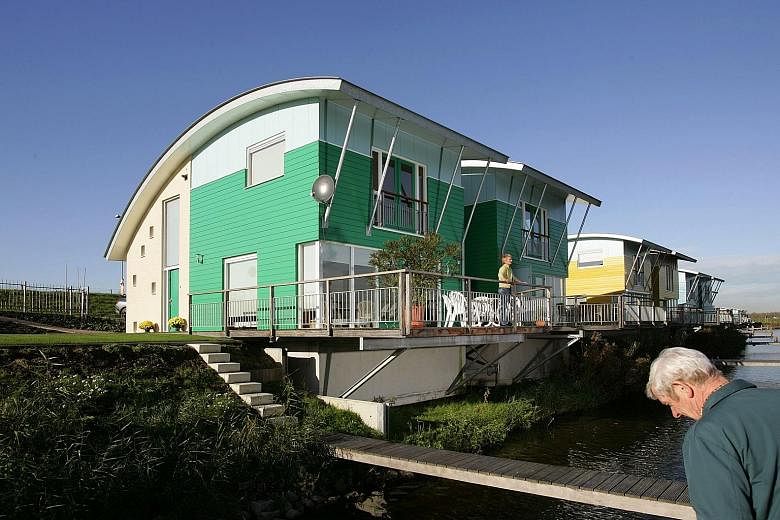With climate change will come rising sea levels, and while Singapore has taken steps to brace itself against the consequences, some experts say more can be done.
Sea levels are projected to rise between 0.25m and 0.76m towards the end of the century, according to Singapore's Climate Action Plan published in 2016 by the National Climate Change Secretariat (NCCS). As a low-lying island, the rise in sea level poses the most immediate climate change threat to Singapore, it said.
Much of the country lies only 15m above the mean sea level, with about 30 per cent of the island less than 5m above the mean sea level.
So the authorities have been preparing early to safeguard Singapore. In 2010, for example, the Building and Construction Authority's (BCA) carried out shoreline restoration works to stabilise a section of the beach at East Coast Park.
Large sand-filled bags were laid several metres into the ground to be level with the low tide, helping to reduce sand erosion.
In 2011, the minimum land reclamation level in Singapore was raised from 3m to 4m above the mean sea level. And last year, Singapore raised the coastal Nicoll Drive in Changi by up to 0.8m.
The BCA is now conducting the Coastal Adaptation Study, which aims to safeguard the country's long-term coastal protection needs, and is expected to be completed by the end of this year.
Today, over 70 per cent of Singapore's coastline is protected with hard structures such as sea walls and rock slopes.
While lauding the efforts, experts have pointed out various ways in which these can be boosted. Visiting associate professor at the University of Adelaide Wong Poh Poh, who also served on the Intergovernmental Panel on Climate Change, believes that another approach which could help is the use of amphibious architecture, which he points out is cheaper than raising land or building sea walls.
Such buildings stay on the ground during dry times. But when water comes, they float on the surface, while their foundations anchor them to the ground.
He gave the example of amphibious homes in Maasbommel, the Netherlands, which have concrete barges anchoring light timber-frame construction on top.
Prof Wong also feels that Singapore should incorporate more natural methods using mangroves to protect coastlines.
He stressed the importance of mangroves - which help to dissipate waves and trap sediment, potentially serving as a flexible form of coastal defence while preventing erosion.
"Utilising mangroves is not only less costly, (but) if the process is done carefully,they are still able to be effective in protecting shorelines to keep up with rising sea levels, which hard methods such as sea walls are not able to adapt to," said Prof Wong.
Assistant Professor Dan Friess, a mangrove expert at NUS' Department of Geography, explained: "Mangrove restoration isn't new in Singapore, with examples on Pulau Semakau and Pulau Tekong, and steps are currently under way to assess the potential for restoration on Pulau Ubin too."
Assistant Professor Winston Chow, also from NUS' Department of Geography, pointed out that not many other countries have "similar constraints" like Singapore in terms of preparing for climate change - given its unique geographical circumstances as a low-latitude island city-state.
More research is needed to look at the impact of climate change on various parts of the urban system, noted Ms Helena Hulsman, associate director of Singapore operations at Deltares, which jointly undertakes applied research in water, subsurface and climate change with NUS under the knowledge alliance NUSDeltares.
Ms Hulsman suggested looking into coastal protection solutions through "building with nature", giving examples of successful pilot studies of ecologically optimised coastal protection solutions in the Netherlands, using natural processes to increase wave dampening, reduce erosion and enhance soil stability.
Architecture such as the Maeslant storm-surge barrier in Rotterdam, the Netherlands, which augments a system of levees and dikes already in place, and the Thames Barrier in London's River Thames, a movable flood barrier, are examples that Singapore can learn from, added Dr Aron Meltzner of Nanyang Technological University's Earth Observatory of Singapore.
Dr Meltzner noted that there were regional fluctuations in sea levels long ago not due to global warming that could happen again in the future, exacerbating the effects of sea-level rise.
To truly combat the problem of rising sea levels, more can also be done to "address the root cause of climate change" by relying more on non-fossil fuel energy sources such as solar energy or hydroelectric energy, said NUS' Prof Chow.
Ms Ria Tan, a nature enthusiast who runs the wildsingapore.com website, believes that the people and the Government need to have more conversations about these issues and how to solve them.
"I feel that more engagement has to be done in the face of rising sea levels as it is also a pressing issue that Singapore faces. More discussions and attention in this area can better allow agencies to understand the concerns of citizens and educate them on the issue, just like how the issue of water is heavily discussed," she said.
Prof Wong agreed that more open discussions have to be held by the government with various groups within societies such as non-governmental organisations and citizens.
He also feels that more people have to be trained to gain expertise in climate change adaptations.
"There is a lot more work to do if we truly want to combat rising sea levels and climate change," said Prof Wong.
•Additional reporting by Rebecca Pazos
Correction note: An earlier version of this article said Associate Professor Wong Poh Poh was an associate Professor of Geography at NUS. This is incorrect. Prof Wong is currently a visiting associate professor at the University of Adelaide, and has retired from NUS since 2010. We are sorry for the error.


